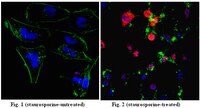ABC26 Sigma-AldrichAnti-PARP1 (cleaved form) Antibody
This Anti-PARP1 (cleaved form) Antibody is validated for use in WB, IC for the detection of PARP1 (cleaved form).
More>> This Anti-PARP1 (cleaved form) Antibody is validated for use in WB, IC for the detection of PARP1 (cleaved form). Less<<Recommended Products
Overview
| Replacement Information |
|---|
Key Spec Table
| Species Reactivity | Key Applications | Host | Format | Antibody Type |
|---|---|---|---|---|
| H | WB, ICC | Rb | Affinity Purified | Polyclonal Antibody |
| References |
|---|
| Product Information | |
|---|---|
| Format | Affinity Purified |
| Control |
|
| Presentation | Purified rabbit polyclonal in buffer containing 0.1 M Tris-Glycine (pH 7.4), 150 mM NaCl with 0.05% sodium azide. |
| Quality Segment | MQ100 |
| Physicochemical Information |
|---|
| Dimensions |
|---|
| Materials Information |
|---|
| Toxicological Information |
|---|
| Safety Information according to GHS |
|---|
| Safety Information |
|---|
| Storage and Shipping Information | |
|---|---|
| Storage Conditions | Stable for 1 year at 2-8°C from date of receipt. |
| Packaging Information | |
|---|---|
| Material Size | 100 µL |
| Transport Information |
|---|
| Supplemental Information |
|---|
| Specifications |
|---|
| Global Trade ITEM Number | |
|---|---|
| Catalogue Number | GTIN |
| ABC26 | 04053252558269 |
Documentation
Anti-PARP1 (cleaved form) Antibody SDS
| Title |
|---|
Anti-PARP1 (cleaved form) Antibody Certificates of Analysis
| Title | Lot Number |
|---|---|
| Anti-PARP1 (cleaved form) - 2526893 | 2526893 |
| Anti-PARP1 (cleaved form) - 3248405 | 3248405 |
| Anti-PARP1 (cleaved form) - NRG1890870 | NRG1890870 |
| Anti-PARP1 (cleaved form) -2673172 | 2673172 |
| Anti-PARP1 (cleaved form) Polyclonal Antibody | 2870517 |
| Anti-PARP1 (cleaved form) Polyclonal Antibody | 3106744 |
| Anti-PARP1 (cleaved form) Polyclonal Antibody | 2925727 |
| Anti-PARP1 (cleaved form) Polyclonal Antibody | 3011369 |








